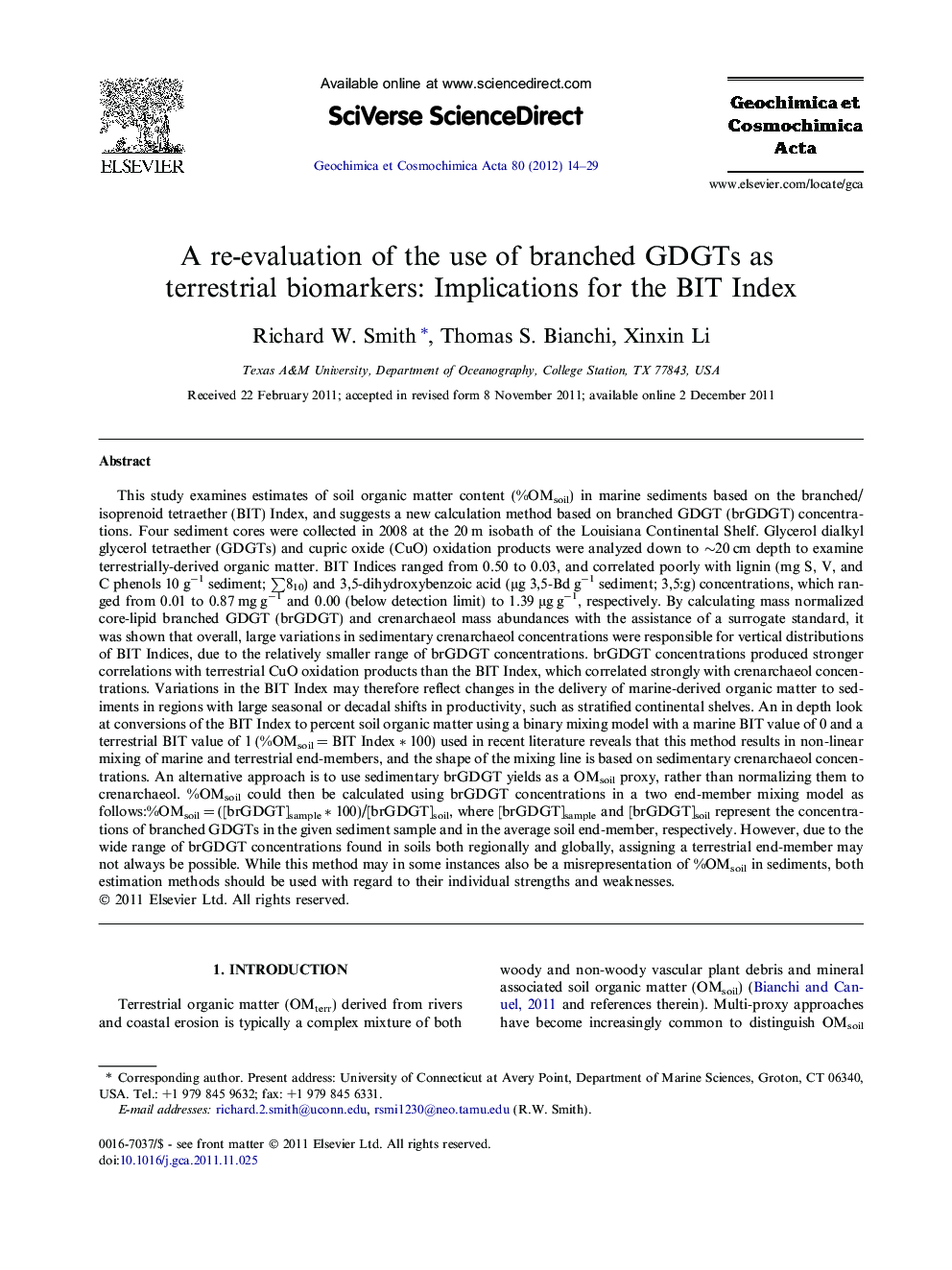| کد مقاله | کد نشریه | سال انتشار | مقاله انگلیسی | نسخه تمام متن |
|---|---|---|---|---|
| 4702825 | 1638077 | 2012 | 16 صفحه PDF | دانلود رایگان |

This study examines estimates of soil organic matter content (%OMsoil) in marine sediments based on the branched/isoprenoid tetraether (BIT) Index, and suggests a new calculation method based on branched GDGT (brGDGT) concentrations. Four sediment cores were collected in 2008 at the 20 m isobath of the Louisiana Continental Shelf. Glycerol dialkyl glycerol tetraether (GDGTs) and cupric oxide (CuO) oxidation products were analyzed down to ∼20 cm depth to examine terrestrially-derived organic matter. BIT Indices ranged from 0.50 to 0.03, and correlated poorly with lignin (mg S, V, and C phenols 10 g−1 sediment; ∑810) and 3,5-dihydroxybenzoic acid (μg 3,5-Bd g−1 sediment; 3,5:g) concentrations, which ranged from 0.01 to 0.87 mg g−1 and 0.00 (below detection limit) to 1.39 μg g−1, respectively. By calculating mass normalized core-lipid branched GDGT (brGDGT) and crenarchaeol mass abundances with the assistance of a surrogate standard, it was shown that overall, large variations in sedimentary crenarchaeol concentrations were responsible for vertical distributions of BIT Indices, due to the relatively smaller range of brGDGT concentrations. brGDGT concentrations produced stronger correlations with terrestrial CuO oxidation products than the BIT Index, which correlated strongly with crenarchaeol concentrations. Variations in the BIT Index may therefore reflect changes in the delivery of marine-derived organic matter to sediments in regions with large seasonal or decadal shifts in productivity, such as stratified continental shelves. An in depth look at conversions of the BIT Index to percent soil organic matter using a binary mixing model with a marine BIT value of 0 and a terrestrial BIT value of 1 (%OMsoil = BIT Index * 100) used in recent literature reveals that this method results in non-linear mixing of marine and terrestrial end-members, and the shape of the mixing line is based on sedimentary crenarchaeol concentrations. An alternative approach is to use sedimentary brGDGT yields as a OMsoil proxy, rather than normalizing them to crenarchaeol. %OMsoil could then be calculated using brGDGT concentrations in a two end-member mixing model as follows:%OMsoil = ([brGDGT]sample * 100)/[brGDGT]soil, where [brGDGT]sample and [brGDGT]soil represent the concentrations of branched GDGTs in the given sediment sample and in the average soil end-member, respectively. However, due to the wide range of brGDGT concentrations found in soils both regionally and globally, assigning a terrestrial end-member may not always be possible. While this method may in some instances also be a misrepresentation of %OMsoil in sediments, both estimation methods should be used with regard to their individual strengths and weaknesses.
Journal: Geochimica et Cosmochimica Acta - Volume 80, 1 March 2012, Pages 14–29